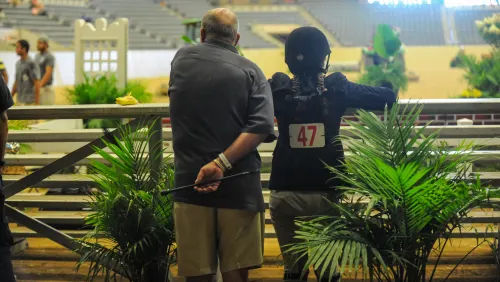Dear Rita,
I know you are sitting on pins and needles waiting to hear the next episode of the Schultheis Chronicles. I hate to leave you hanging in the tangles of his rose garden, but I have to surge off on a tangent for a minute. A bit of half-pass to the right please…
While it is true that I have adhered largely to the Schultheis School in my method of riding, I am an open-minded person, and I am always trying to improve my skills. My years with Bodo Hangen and Rudolf Zeilinger (both students of Schulteis) contributed much to the development of my craft, and my current training with Morten Thomsen continues to do the same. All of these men have increased my dedication to the Schultheis School while pushing me to expand my pool of knowledge.
I rely heavily on throughness in my daily training at all stages of development with my horses. My goal is a supple, powerful athlete that calls up instant impulsion when I ask for it and downshifts into a calm-but-ready state when I relax my own body. I want my horses reading my body language and not concentrating on what I do with my hands.
Generally speaking, I try always to ride forward toward the bit, no matter where I ask my horse to position his neck. Left, right, up, down, flat, round…I like my horses to respond in a soft manner to whichever position I indicate and then either relax in that position or step through from behind with intense energy and power. I often tell my students—position the frame where you want it, then leave the horse free in the neck so that you can ride the hind legs into your hands.
Bodo used to say to me: Play the neck like an accordion. Longer, shorter, higher, lower.
Schultheis used to say to me: Away with your hands. Poll high! SIT! FORWARD!
Zeilinger used to say to me: Relax. Flatter neck.
ADVERTISEMENT
Thomsen says to me: When your horse wants to put his neck down, ride it up. When he wants to put the neck up, ride it down. You have to be able to ride where you want to ride.
I am not a rider of extremes. In nearly all facets of my life, I have learned that the middle way is almost always the best way. I believe that in riding as well. Therefore I do not ride in hyperflexion, and I do not train my horses into a frame that is too high for them to carry.
I do sometimes ride behind the vertical or with the poll lower than the crest of the neck. I do sometimes challenge my horse to carry his poll higher than he would like to or to open his frame beyond the vertical. Anyone trying to achieve Mastery in this sport should be able to do the same.
Having said all that, let me be clear about this: The best feeling I ever have on any horse is when I could ask for more impulsion with the poll carried willingly at the highest point, and when my horse has responded by stepping through from behind without resistance.
Because all of my training is geared toward reaching this ideal state, most of my training takes place in the process of getting there.
I have spent a lot of years embedded in the world of top dressage sport. I have seen good riding on overflexed horses, and I have seen bad riding in a correct frame. Riding with the frame up or down does not define good riding. A rider can ride badly with hands, bits, whips and spurs in any frame.
So look for good riding and when disappointed, don’t blame the system. It is the Archer, not the arrow, who has missed the mark.
Diversity is necessary in life, and it is also necessary in dressage training. Taste it so that you can find the middle road.
ADVERTISEMENT
Oh believe me, Rita, I have only touched the tip of the iceberg on this one.
I’m Catherine Haddad and I’m sayin it like it is from Vechta, Germany.
Training Tip of the Day: Can you play your horse’s body like an accordion?
This video clip is a demonstration of me playing the accordion. This is not an actual training session. I took four minutes out of my warm-up today to totally confuse my horse for you, Dear Rita. Do not attempt this on a Shetland pony.















